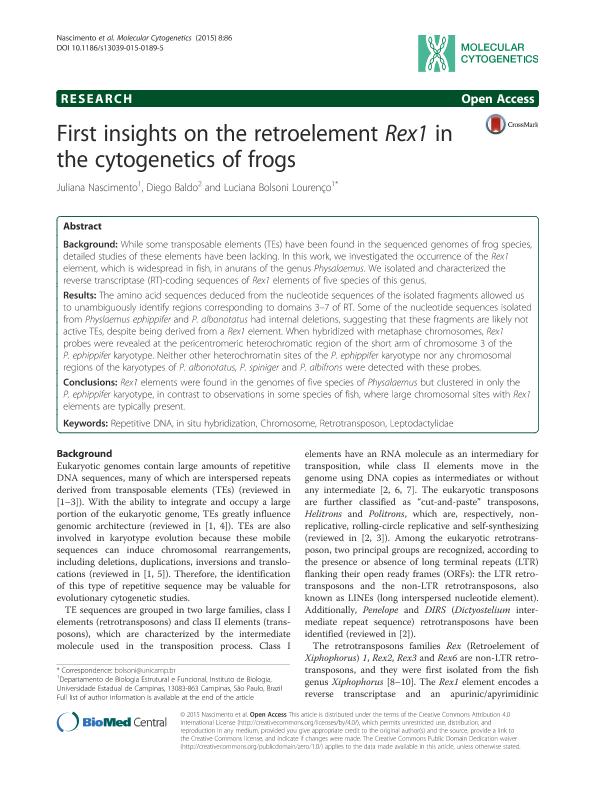Mostrar el registro sencillo del ítem
dc.contributor.author
Nascimento, Juliana
dc.contributor.author
Baldo, Juan Diego

dc.contributor.author
Lourenço, Lucina
dc.date.available
2018-03-01T18:27:16Z
dc.date.issued
2015-11
dc.identifier.citation
Nascimento, Juliana; Baldo, Juan Diego; Lourenço, Lucina; First insights on the retroelement Rex1 in the cytogenetics of frogs; BioMed Central Ltd.; Molecular Cytogenetics; 8; 86; 11-2015; 1-9
dc.identifier.issn
1755-8166
dc.identifier.uri
http://hdl.handle.net/11336/37562
dc.description.abstract
Background: While some transposable elements (TEs) have been found in the sequenced genomes of frog species, detailed studies of these elements have been lacking. In this work, we investigated the occurrence of the Rex1 element, which is widespread in fish, in anurans of the genus Physalaemus. We isolated and characterized the reverse transcriptase (RT)-coding sequences of Rex1 elements of five species of this genus. Results: The amino acid sequences deduced from the nucleotide sequences of the isolated fragments allowed us to unambiguously identify regions corresponding to domains 3-7 of RT. Some of the nucleotide sequences isolated from Physlaemus ephippifer and P. albonotatus had internal deletions, suggesting that these fragments are likely not active TEs, despite being derived from a Rex1 element. When hybridized with metaphase chromosomes, Rex1 probes were revealed at the pericentromeric heterochromatic region of the short arm of chromosome 3 of the P. ephippifer karyotype. Neither other heterochromatin sites of the P. ephippifer karyotype nor any chromosomal regions of the karyotypes of P. albonotatus, P. spiniger and P. albifrons were detected with these probes. Conclusions: Rex1 elements were found in the genomes of five species of Physalaemus but clustered in only the P. ephippifer karyotype, in contrast to observations in some species of fish, where large chromosomal sites with Rex1 elements are typically present.
dc.format
application/pdf
dc.language.iso
eng
dc.publisher
BioMed Central Ltd.

dc.rights
info:eu-repo/semantics/openAccess
dc.rights.uri
https://creativecommons.org/licenses/by-nc-sa/2.5/ar/
dc.subject
Chromosome
dc.subject
In Situ Hybridization
dc.subject
Leptodactylidae
dc.subject
Repetitive Dna
dc.subject
Retrotransposon
dc.subject.classification
Otras Ciencias Biológicas

dc.subject.classification
Ciencias Biológicas

dc.subject.classification
CIENCIAS NATURALES Y EXACTAS

dc.title
First insights on the retroelement Rex1 in the cytogenetics of frogs
dc.type
info:eu-repo/semantics/article
dc.type
info:ar-repo/semantics/artículo
dc.type
info:eu-repo/semantics/publishedVersion
dc.date.updated
2018-03-01T13:50:13Z
dc.identifier.eissn
1755-8166
dc.journal.volume
8
dc.journal.number
86
dc.journal.pagination
1-9
dc.journal.pais
Reino Unido

dc.journal.ciudad
Londres
dc.description.fil
Fil: Nascimento, Juliana. Universidade Estadual de Campinas; Brasil
dc.description.fil
Fil: Baldo, Juan Diego. Consejo Nacional de Investigaciones Científicas y Técnicas. Centro Científico Tecnológico Conicet - Nordeste. Instituto de Biología Subtropical. Instituto de Biología Subtropical - Nodo Posadas | Universidad Nacional de Misiones. Instituto de Biología Subtropical. Instituto de Biología Subtropical - Nodo Posadas; Argentina
dc.description.fil
Fil: Lourenço, Lucina. Universidade Estadual de Campinas; Brasil
dc.journal.title
Molecular Cytogenetics
dc.relation.alternativeid
info:eu-repo/semantics/altIdentifier/doi/http://dx.doi.org/10.1186/s13039-015-0189-5
dc.relation.alternativeid
info:eu-repo/semantics/altIdentifier/url/https://molecularcytogenetics.biomedcentral.com/articles/10.1186/s13039-015-0189-5
Archivos asociados
